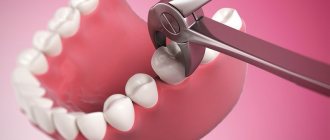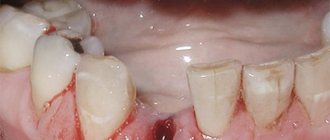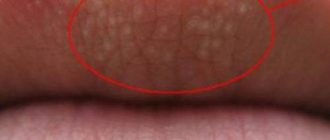A bridge on implants is a reasonable option for prosthetics in case of loss from 3 teeth to their complete absence. Cheaper than implantation of each lost tooth, more reliable than bridge prosthetics on your own teeth.
In our Center they are installed after computer diagnostics and bite examination, and are manufactured in our own dental laboratory. A lifetime warranty is provided for implants in our Center, and 25 years for metal-free crowns as part of a bridge.
A dental bridge on implants is a non-removable orthopedic structure made from welded crowns to restore several teeth in a row.
- Difference from traditional bridges The bridge is supported not by your own teeth, but by pre-installed implants. There is no need to grind down the enamel of adjacent healthy teeth.
- Difference from classical implantation Each tooth does not require a separate implant; fewer are installed. And the bridge includes crowns for each tooth. Allows you to save money.
Bridge prosthesis on implants
Advantages
If you lose several teeth in a row, dental bridges on implants are the right solution. Allows you to correctly distribute the load and not use healthy teeth.
- Neighboring teeth do not deteriorate. The supports are implants implanted into the jaw, and not your own teeth, which must be ground down.
- Durability Implants last a lifetime, and the service life of the prosthesis is at least twice as long as that of classic bridges.
- Aesthetics Crowns are no different from your own teeth. The aesthetic gingival contour is recreated.
- Affordability Savings compared to classic implantation, when each tooth is replaced with an implant and a crown.
Nuances of care
Caring for a bridge
There are different options for connecting the intermediate part of the prosthesis and the mucosa, but most often it is the flushing type. There is free space under the body of the structure, which greatly simplifies hygienic care and also prevents the accumulation of plaque and deposits.
For high-quality cleaning of the rinsing space and hard-to-reach places, it is recommended to use a special dental brush and irrigator. Otherwise, oral care remains the same - you should brush your teeth at least twice a day and do not forget to rinse your mouth after each meal. Every six months, you must visit the dentist for preventive examinations and, with the same frequency, undergo professional cleaning to remove plaque and deposits.
In our dentistry in Moscow you can undergo prosthetics using modern technologies and materials. Our team consists of experienced, highly qualified specialists who find an individual approach to solving each clinical problem. You can find out the prices for the clinic’s services by looking at our price list.
Still have questions? We will be happy to answer them - call and sign up for a free consultation!
Date of publication: September 20, 2020 Last update: September 22, 2022 © 2020 Professorial Dentistry “22 Century”. All rights reserved.
Is it always possible to put a bridge on implants?
A bridge prosthesis on implants is suitable in any clinical situation, regardless of the extent and location of the defect in the jaw
Installed when:
- loss of three adjacent teeth in a row; with fewer teeth there is no need
- absence of outer teeth in a row , when there is no support on one side for a conventional bridge
- complete edentia , when there are absolutely no supports for fixation for a traditional bridge
Bridges on implants do not require grinding of adjacent teeth.
They are used even in cases of terminal defects and complete edentia, which cannot be achieved with traditional bridge prosthetics. Another undoubted advantage is that there is no need to prepare the enamel of neighboring teeth, which means they will remain healthy and last longer.
Levin Dmitry Valerievich Chief physician and founder of the Doctor Levin center
What are dental implants
Implant-supported prosthetics differs from classical prosthetic technology. The method is based on the rehabilitation of the dentition without the involvement of healthy units. Instead of a missing or non-viable tooth, a separate implant is implanted - a titanium root that imitates a natural one, onto which an orthopedic structure (crown, bridge, complete denture) is fixed. With the help of dental implants, any number of units can be restored - from 1 to all in a row.
How many implants are needed for partially missing teeth?
When calculating the number of implants, we take into account the distribution of chewing load
The load on the jaw when chewing should be uniform so that there is no subsidence of the gums and bone tissue under the hinged crowns. This will ensure the durability of the prosthesis and maintain aesthetics. Therefore, fixing a bridge on 2 implants is not always the right solution. It is recommended to use a 1:2 calculation - one implant for 2 crowns . Accordingly, the more teeth are missing, the more implants will be needed.
1-2 teeth missing
In this situation, bridges supported by implants are not relevant; teeth are restored separately. Each one has its own implant, which is covered with a separate crown. In this case, it is not recommended to combine crowns - if one is damaged, you will have to remove two at once. No 3 teeth
The most common clinical picture.
If there are no three adjacent teeth in a row, 2 implants are implanted along the edges of the defect, and a prosthesis for 3 teeth in the form of interconnected crowns is fixed on them. The outer ones are mounted on supports, and the middle one is hinged. You can install three implants, but this solution is cheaper. 4 missing teeth
When installing a bridge on 4 missing teeth in a row, the number of supports increases to three, and the number of crowns increases to four.
If you use two supports, then there will also be two mounted crowns. Atrophy of the jaw bone under the prosthesis cannot be ruled out due to uneven load. And the risk of prosthesis breakage increases due to increased pressure on the central part. No 5 teeth
Bridge prosthetics on implants is possible for 5 teeth or more. If five teeth are missing, three implants are needed. If a bridge of 6 teeth or more is required, three supports are used - the number is calculated by the number of crowns in the structure. The degree of future load and its distribution on the bone tissue are taken into account to prevent atrophy.
Dental bridges in dentistry
A bridge prosthesis or bridge is a one-piece structure that makes it possible to restore individual previously removed or fallen out teeth. It is fixed on two adjacent pre-turned support units.
Advantages and disadvantages
Each type of treatment has its positive and negative sides. Advantages of dentures with bridges :
- speed of installation;
- aesthetically the bridge looks very natural;
- the design does not contain metal;
- no contact with gums;
- the procedure is not traumatic;
- reliable fixation;
Flaws:
- grinding of adjacent units is required;
- unskilled work by a doctor can lead to damage to healthy teeth under the prosthesis;
- short service life;
- when the bridge is chosen incorrectly, periodontal overload may occur;
- sometimes there is a feeling of discomfort when wearing;
- the development of bone atrophy cannot be excluded.
Even with good care, bridge systems will not last long. Plus, during use they change color, wear out, and sometimes cause allergic reactions.
What complications can there be?
Immediately after installing the bridge, a person experiences unpleasant sensations. This is due to the adaptation of the receptors of the tongue and cheeks. Three days later the situation returns to normal. In case of prolonged discomfort, polishing by a specialist may be required. It should not be neglected, otherwise, due to irrational load, the structure may crack , or the supporting teeth will begin to hurt.
During operation of the bridge, food may become clogged under it. This cannot be avoided. Space is deliberately left between the gum and the denture, otherwise there is a risk of bedsores. The problem can be solved by using a toothbrush, irrigator, or floss.
It happens that the bridge comes unstuck. If this happens almost immediately after installation, the cause is most likely due to accidental ingestion of saliva during fixation. There is no need to delay visiting the dentist. This threatens to displace the structure . An allergic reaction may occur . The phenomenon is uncommon, but occurs periodically.
The result of rejection of the bridge structure can be intoxication of the body. Such cases must be urgently addressed in a clinical setting.
Full bridges for the lower and upper jaw
In case of complete edentia, fixed bridge structures are reinforced with a metal arch
The arch unites the crowns, increases the strength of the bridge and allows it to withstand severe chewing loads. The number of implants is determined depending on the clinical picture, anatomical features and jaw size.
- In the upper jaw, bone tissue has a lower density, therefore, during implantation, a larger number of implants are used - 8 pieces.
- On the bottom , on the contrary, the bone is denser, so 6 implants are enough for complete prosthetics. This is subject to standard jaw sizes. If the patient has a large jaw, two more implants are added to evenly distribute the load and ensure safe operation of the prosthesis.
A dental bridge with 6 implants is usually solid, but a denture with 8 implants can be made segmented - from four sections. This is a more convenient option - if necessary, you can remove only one segment, and not the entire prosthesis.
Also, in case of complete absence of teeth, the All-on-4 and All-on-6 protocols are used. 4 or 6 implants are installed on one jaw in a certain way, observing the principles of load distribution. Immediately on the day of implantation, a temporary non-removable adaptive prosthesis is installed, and after 6 months it is replaced with a permanent one.
What materials are they made of?
Dentures are manufactured in the Center’s own dental laboratory, you can choose the appropriate option to suit your taste and budget
- Metal-ceramic The base of the crowns is a metal alloy, the top is covered with ceramic mass. Relatively inexpensive, yet durable and quite aesthetic. The main disadvantage of metal ceramics is the ability to oxidize and cause a bluish outline to appear on the gums over time. Service life - 15 years or more .
- Zirconium Can be all-zirconium or coated with ceramics. They can withstand any load, do not deform, and retain their original appearance. Identical to natural teeth, the shade is selected individually. More expensive than metal-ceramic ones, but last longer. Service life - 25 years or more.
We offer patients the most profitable and practical methods, so we reserve the advantage for metal-free structures. In our Center, dental bridges are created in our own digital production using Zirkonzahn Schule technology or at the PROCERA (Nobel Biocare) plant in Sweden.
Stages of installing a bridge on implants
The process includes several stages - diagnostic, surgical and orthopedic
Diagnostics and planning
Computer diagnostics are carried out, the data is necessary to assess the quality of bone tissue, and is used for virtual planning of the operation. In case of extended defects and complete absence of teeth, a bite examination is performed on an articulator so that after prosthetics the correct closure of the jaws is maintained. The treatment plan is drawn up by the orthopedist - he is the one who coordinates the work of the implantologist, determines the positioning points and the number of implants, taking into account future loads.
Implantation
During the operation, a calculated number of implants are implanted into the jaw. When bone tissue atrophies, osteoplasty is performed - bone tissue augmentation. This is necessary to create reliable fixation of the implants. We work only with premium Nobel Biocare systems and use original prosthetics . For anxious patients with cardiac problems, the possibility of surgery in medicated sleep is provided.
Temporary prosthetics
It will not be possible to install a permanent prosthesis immediately after implantation - you cannot create a strong load so as not to disturb the position of the implants. But you will never leave our Center without an orthopedic solution. On the same day, we will manufacture and install a temporary bridge from lightweight materials, which will hide the defect and last 2-4 or 6 months while the implants take root.
Permanent prosthetics
Permanent bridges are made after fittings and prototyping, taking into account the bite. Installed using transocclusal (screw) fixation. Unlike cement fixation, which is practiced in some clinics, the bridge, if necessary, can be removed without damaging the abutments (the connecting link between the implant and the prosthesis).
Bridge on implants or your own teeth - comparison
Each type of prosthetics has its own indications, advantages and disadvantages.
| Tooth-supported bridges | Implant-supported bridges |
| Prosthetic options Up to 3-4 teeth, not suitable for end defects | Prosthetic options From 3 teeth in a row to complete absence |
| Grinding of adjacent teeth is required | Grinding of adjacent teeth Not required |
| Reliability of fastening Possible tooth mobility due to periodontal diseases and inflammation | Reliability of fastening Complete stability due to the fusion of implants with the jaw bone tissue |
| Probability of bone atrophy High - the bone in the area of the defect dissolves and decreases without load | Probability of bone atrophy Low - the load on the bone is uniform due to the installation of the required number of implants |
| Service life Up to 7 years, depending on the condition of the supporting teeth | Service life of a prosthesis - from 15 years, implants - a lifetime |
| Price Lower - costs only for prosthetics | Price Higher - the cost of implantation is added |
In all respects, bridges on implants are superior , the only drawback is the cost in financial and time terms. First, implantation is performed, which requires additional costs and time.
A permanent bridge can be installed only after the implants have healed in order to avoid their displacement during chewing. But this does not mean that you will be left without teeth during this period. Immediately after the operation, we will make a temporary prosthesis that will last until the permanent one is installed and will hide the work performed. You will never leave our Center without teeth!
Contraindications to the installation of metal ceramics
If you need to replace teeth, metal ceramics are an excellent option for dentures. It has been mentioned more than once about the aesthetics and anatomical accuracy of this material, as well as the natural shine and shade of crowns and dentures, which creates an absolute resemblance to a natural tooth. However, it is not always possible to use metal ceramics. In case of periodontal and chewing muscle diseases, malocclusion, pathological abrasion of dental tissue, as well as for children and adolescents, this type of prosthetics is undesirable.
Service life of bridges on implants
Implant-supported bridges have increased stability compared to bridges supported on your own teeth. The period of operation does not depend on the condition of the supporting teeth, which over time can become loose from increased loads.
Implants create a uniform load on the bone tissue, eliminating subsidence of the bone under the prosthesis, thereby extending the service life of the structure. Metal-ceramic dentures last from 10 years, zirconium – from 25 years.
a 25-year guarantee on metal-free crowns supported by implants . The Center's warranty on the implants themselves . We use only premium Nobel Biocare implant systems and original prosthetics.
How much does a metal-ceramic crown cost?
The cost of metal-ceramic crowns varies; it can cost two thousand, as much as six thousand, or even more. It all depends on what material was chosen for the crown. Naturally, a crown made of ordinary metal will be much cheaper than a crown made of gold or titanium. But at the same time, the last two materials are much more durable; such prostheses will last much longer.
How much does it cost to install metal ceramics?
If you're not a big fan of brushing your teeth, it's likely that you'll soon be a candidate for dental implants.
But you can lose a tooth even if you take good care of your teeth. What material is best for a prosthesis? Metal teeth do not look very aesthetically pleasing, but porcelain crowns are quite fragile. The best option is metal ceramics. When making metal-ceramic teeth, the metal crown is covered with a special layer similar to enamel.
The cost of installing an implant consists of the cost of materials, as well as the cost of work. How much does a metal-ceramic bridge cost?
Bridges are used when a tooth is partially destroyed. A bridge is a prosthesis for extracted teeth; it is practically suspended between two teeth.
The cost of this type of prosthetics is not as high as it might seem. Such a prosthesis will cost much less than replacing damaged teeth with implants.
If you decide to install metal ceramics, you can safely contact the MEDFAMILY network of dental clinics. Our branches are represented in the South-Western Administrative District, Southern Administrative District, and Northern Administrative District of Moscow.
What does the cost consist of?
Our Center provides a case payment system
The implant installation case includes:
- local anesthesia;
- cost of the Nobel Biocare implant and its installation;
- consumables and superstructures;
- applying and removing sutures;
- control CT diagnostics after surgery.
The case for installing a bridge includes:
- taking impressions;
- production of prosthesis;
- fitting and fixation of the structure.
Paid separately:
- Diagnostic case before implantation - the cost depends on the necessary studies.
- Osteoplastic surgery if necessary - the price is calculated depending on the type of bone augmentation and the duration of the defect.
- Sedation - calculated for each hour spent in medicated sleep. Usually 1 hour is enough to install 2-3 implants.
The total cost of bridge prosthetics on implants is formed taking into account:
- length of the defect;
- type and number of implants;
- number of crowns in the structure;
- the need for osteoplasty;
- use of sedation.
Advantages of crowns and dentures made of metal-free ceramics
Dental crowns made of metal-free ceramics are made in strict accordance with the natural color and shape of the patient’s teeth.
The products are not equipped with a metal frame; its role is played by a base made of especially durable ceramics. This technology is ideal for the restoration of front teeth, since the crown is indistinguishable from a living tooth. In addition to crowns, dentures can also be made from it. Porcelain does not come into contact with the environment, therefore it is absolutely harmless to the body. Therefore, it has become a real discovery in modern dentistry and is called the most advantageous and safe technology.
In terms of its aesthetic properties, it is very similar to living teeth. It is characterized by the same degree of light refraction as natural tooth enamel. Moreover, even a highly qualified dentist will not be able to visually distinguish between a crown made using the latest technology and a real tooth. When making crowns, the individual characteristics of the patient’s “native” teeth are always taken into account. It turns out that the cosmetic effect of this modern material is one hundred percent.
However, do not forget that practicality is as important as beauty. Not so long ago there was an opinion that ceramics are only for the front teeth, that is, really only for beauty. In fact, at first, ceramic crowns were not designed to withstand any loads. But the latest casting technology has solved this problem. Crowns obtained using this method are much higher quality and stronger than their predecessors, and therefore are popular with both patients and dentists. Of course, before starting dental reconstruction using the latest methods and materials, the patient should get an idea about metal-free ceramics, prices, reviews, and also consult with his dentist. By the way, you don’t have to worry about the fact that you will have to experience certain inconveniences from the moment you order permanent structures until the moment they are installed. There are temporary crowns that hide the defect and allow the patient not to experience
Now about the cost: it directly depends on what material is used for the crown.









